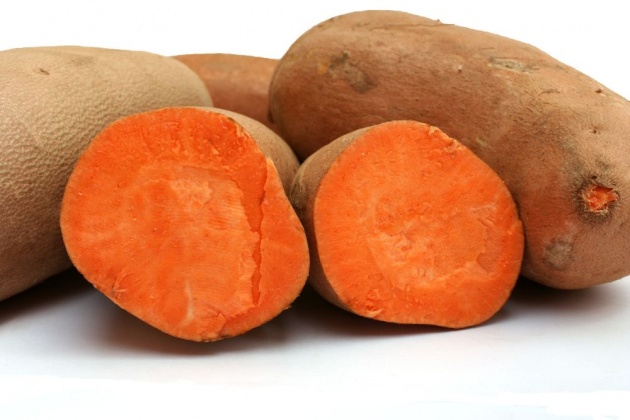The sweetpotato (Ipomoea batatas L.) is a member of the Convlvulaceae or Morning Glory, family. The genus, Ipomoea, contains 400 or more species widely distributed over the
world, chiefly in tropical countries. The sweetpotato is a tuberous-rooted perennial, although, it is grown as an annual in the United States (Thompson, 1929). The sweetpotato is a long season annual and requires a warm growing period of 100 to 150 days for profitable yields. It has been suggested that its origin was Central or Tropical America or the West Indies (Hammett and Ammerman, 1973).
Sweet potato is a major food crop worldwide. It is grown in tropical and subtropical areas. In the United States, the south, southeast and southwest regions are the main production areas. Sweet potato is one of the major crops of Mississippi farmers and ranks number five. In 1989, the land area under sweet potato cultivation in Mississippi was 3,000 acres, and it increased to 6,000 acres by 1993. Although large amounts of the harvested crop are processed, sweetpotatoes are primarily produced for the fresh market.
Sweetpotato storage roots are mainly composed of carbohydrates. They are a major source of carbohydrates for the human diet in the world. Sweetpotato storage roots can be held for 10 to 12 months with proper curing and storage, (Francois and Law 1971). The main contribution to such losses may be due to injury by mechanical harvesting. Injuries to storage roots has shown to accelerate respiration rates. Injuries are not only avenues of entrance for disease organisms and sites for water loss, but also contribute to poor quality fresh market storage roots.
High rates of respiration and transpiration are considered responsible for weight loss and alteration of internal and external appearances in sweetpotato roots. Picha (1986d) reported that the highest rate of respiration was on the day of harvest. Respiration decreased during curing, and during the first 14-18 weeks of storage. According to his observations, transpiration was the major source of weight loss in the early stages of storage. Respiration contributed more to total weight loss during the latter period of storage. Kushman and Pope (1972) recorded dry matter loss due to increased temperature, storage period, and respiration rate. Many physiological changes that affect the internal composition of sweetpotato roots, occur during curing and storage (Kushman and Wright, 1969). Using proper curing techniques (4-10 days at 30-32oC and 90% RH) and optimal storage conditions (15.6oC and 90% RH) storage roots can be held up to a year, without sprouting or serious decay (Kushman and Pope, 1972). Hardcore, another physiological disorder was markedly reduced by 5% CO2 in the storage atmosphere (flushed after 24 hours). Carbon dioxide seems to be an inhibiter of ethylene reactions. However, accumulation of CO2 in the storage environment had different effects at chilling and non-chilling temperatures, resulting in 24.9 and 35.2% hardcore respectively (Timbie and Haard, 1977).
The dry matter of sweetpotato storage roots is mostly carbohydrate in the form of starch and sugars. Sucrose is the major sugar and glucose and fructose are the main reducing sugars after curing (Hopkins and Philips, 1973). Picha (1986a) found different carbohydrate quantity and pattern changes among sweetpotato cultivars, during curing and storage. `Travis' contained the most total sugars and `Whitestar' the least, on a dry weight basis. Sucrose sharply increased both during curing (10 days at 30oC; 90% RH) and during a 46 week storage period at 15.5oC. Sucrose concentrations decreased in two white-fleshed cultivars after curing, followed by an increase after 14 weeks of storage. Glucose concentration was slightly higher than fructose in all the cultivars except "Centennial" which had similar fructose and glucose concentrations. The pattern of monosaccharide change during curing and storage varied with cultivars. Generally an increase in monosaccharide occurred during curing and the first 4 weeks of storage.
Since sweetpotato have a high content of carbohydrates, active amylase and other enzyme systems, there is a rapid breakdown in firmness and discoloration occur unless rigid conditions are met during handling of storage roots. Factors related to softening are not clearly known and chemical changes for loss of firmness have not been defined sufficiently. Discoloration in storage and peeling create a lot of problems associated with processed sweetpotatoes (Sistrunk, 1971).
The plant material for this experiment was four commercially grown cultivars. Therefore, the positive effect of modified atmospheric curing on curing and storage on storage roots of these cultivars must be known. Such information is needed to make recommendations for commercial curing, storage and marketing of these commercially grown cultivars. 



